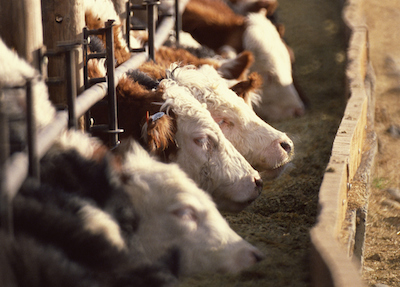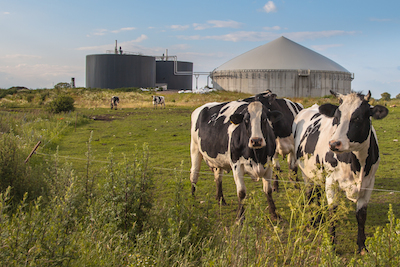Chapter 10. From Cow Manure to Electricity
From Cow Manure to Electricity

Read the article below. Then answer the questions that follow.
Dairies produce vast amounts of waste

When dairy cows produce milk, they leave a lot more behind. In a typical 1,000-cow barn, 8,000 gallons of manure are rinsed from the floor, three times every day! Dairies pump the waste to large holding lagoons. These murky ponds can stretch for seven acres or more, and as the waste decomposes hundreds of pounds of methane gas are released into the atmosphere every year.
This causes a big problem for the environment. Methane is 20 times more potent a greenhouse gas than carbon dioxide—the gas emitted by cars and trucks. When you add up all the dairies across America, this has a big impact. It has been estimated that one-third of global methane emissions come from the livestock on farms and dairies.
This is why farmers in New York, California, and many Midwestern states have begun capping their holding lagoons with thick plastic so strong you could walk on it. These tarps collect the methane in giant bubbles as much as thirty feet in height. Other dairies pump their manure directly into tanks and domes for decomposition.

The creation of methane
Whether the manure decomposes in an enclosed lagoon or in a holding tank, naturally occurring bacteria eat away at the sludge and produce methane gas through a process called methanogenesis. The organisms that turn waste into methane belong to the archaea class of microbes and are called methanogens. Archaea are found in extreme environments such as bogs and deep ocean vents. Methanogens generally don’t like oxygen, and thus are considered anaerobic. They also like to hang with anaerobic bacteria such as the ones that perform fermentation reactions.
Methanogenesis usually follows fermentation, and marks the final step in the decomposition of biomass. Fermentation—which also happens during wine making, beer brewing, and elsewhere—breaks organic acids into hydrogen and carbon dioxide. If these gasses build up, bacterial fermenters quit working. This is why methanogenesis is so important; it removes these gasses, allowing fermentation to continue. Without this critical stage, branches, algae, and other organic gunk would accumulate in the bottom of bogs and lakes, and in other anaerobic environments.
Methanogenesis also occurs in the guts of cows, where methanogens break down the by-products of fermented grass. Nutrients are absorbed by the body, while methane gas is released by belching and flatulence. Methanogens found in the manure cows excrete create additional methane as the manure breaks down in the ponds created to hold it. Methane digesters are created by simply capping these holding ponds, or by pumping the manure into an enclosed structure.
All you other energy sources, moo-ve over!
As we have discussed, harvesting methane gas from an enclosed structure isn’t complex. Clean-burning generators can then make electricity from methane biogas. A single 1,000-cow dairy can make enough energy to continuously power 600 local homes, as well as its own operations.

Farmers can opt to sell this energy back to the grid. Special power lines are brought to the dairy, and the energy generated is sent back to the utility company. Dairy farmers can make more than $100,000 a month from the electric company, which then profits by selling the power to customers. If you live near a dairy, you may one day be buying local bioenergy created in this way!
Beyond dairies
Cow manure isn’t the only source of biomethane. The gas is produced when just about anything rots. Methane digesters have been set up at sewage treatment plants, landfills, and even at vineyards (to break down mashed grape skins). This converts waste into electricity.
Researchers are now beginning to test the ratios of these starting products, and comparing their final methane yields. It turns out that adding crude glycerol—the primary waste product made during biodiesel manufacturing—may increase methane yields for the same volume of substrate—or the starting product the microbes break down. Digesting a mixture of glycerol and wine waste might make more methane than wine waste alone, although this is still being investigated.
To test this working hypothesis, researchers at Sonoma State University recently opened a series of test digesters at the Santa Rosa Laguna Treatment Plant in California. A portion of the plant’s power comes from methane generated from human solids, and now two new experimental digesters will be used to compare yields from other kinds of waste products. Mixing the right kinds of waste together might encourage the bacteria and archaea to perform at their peak.
If these technologies are integrated at the mass scale, they will help reduce dependency on fossil fuel.
Dairy Energy & Pollution
Dairy energy is not entirely free of pollution. Like any combustion engine, the generator that converts methane into electricity produces nitrogen oxides. These air pollutants have been linked to asthma.
In one year, a clean burning dairy generator releases about the same amount of nitrogen oxides as one long-haul truck produces in a year. Technology is being developed to help capture this pollution, much like the filters used at electricity plants, which also release nitrogen oxides.
Dairy energy is still a lot cleaner than coal, which also releases nitrogen oxides.
© 2015 WH Freeman and Company.
10.1 Comprehension Questions
Answer the following questions to demonstrate your understanding of the article.
Question 10.1
True/False:
A 1,000-cow barn can produce as much as 8,000 gallons of manure a day.
IkLyhbbYRLnR0DDUHGa+YA==
Question 10.2
gRaoIrhxDh2U8u6il0E7JLo1Om8DRhLdDFBB/CDkwOLwDo5Zz10DevM6trN9TfiDncKuhXBrRgKZrzDq7tMCLkMdafE21UKWxLRbl12mrnH5BRzffWZDCrmLhChU5D6cqMG+H01G5LBd7I6dTdcqVmGTEhC1GJr+ezRhkyMTPq8FIf19tGjMi/0vr1zU/R/HqBrlHyy26k4gyVFA8SvkJjZpu4KeDrwMMBFxvWwRFvH4VSGWokXVa80+MI+Kt3hgpvZalrL4AjPOETG0FSInE/gAh2w29U5dLg8EfPeZXOkKN5aeElUvU26km0CSrIitIrP/tu0ZIAm3gdhy/jk+P/Dk/de/cXeho5LW3lQL/HsztOjDbtnFCXSVch8qL+TOI5mgPeCcb70y2XDjIFuzw+bfxSsVtoRN57mU3RWQbGInf/sBO/6il0xFO23TDg07tpewOp5E9CgQ6KVybh1dSCFBrIFjUGc+DSyHwIJ5I7ZIc4qLp0e0S7pnXzKyUcLvV77NMfG3KfoAh1zw37nsHtMfmRjbUDG8kpTKyXyOJyC0/d/mw5y4tHazJWbpzzsJYheEB9YMzqHY69KLQkHjwCzd6qr19kgvZsxd70xS9j/KQs9971la8mpOfCjRMZEGTBadkbP5me1WZZ/AZLUpLIGkF29H6JggwoGzjJlV/KFiBeAGkunGxGc5s4xQ5h5YRrzYZbxjcWfYeQ7kshchIzcbhfPsxepiK/Y4uJIBeMTmmcKGWNeMmkY4ycO4PiNc7Mi2zTVSRqq0JLclJbAqJr6hl/YPlyCtoYiju2O+Pc+U06e3GsT/9XZwIR5sHEvAMM4f9YiBnPd2BNkSJDq+R+qBsurS9h8EZYBlyUHa/XRPzFStyDnOzvktg7FOjmjElKMfdA==Question 10.3
/ArekgyIE5VwK5M75OXzKHhc5rTrLihX4w7KtAkxyaeSZ1qcJbxoqvO35ceJuYz5i0jBS8yzPeo23uOuwJ05NaEv/EjGw2cfC6N2/hhzfSlojwY+CjhHJkqkGgvqO2Nckhnx++a6A1umhPX4/Vnma91DyB+7uEi92iMPCTW6POYZDCuZkpKqLdIkaBQVJydz0F781oDTcHmKB2JiqxTq9OEYDHLRlUxb/RnGlHyrq5z2nfsKt3Lx+juF60jiY+/x0jALhJHJbcnLj7IvML154hrUXyihDyoVfjCFS8upyv1NRDWW4IpWWNLSKr1jS0zBmu+rRHziVxq2tWCGHNTs64/xkBsW/TAlAdwMIRSe9ttatIzHy96HJ/dpFxOLD/tlD35wIgUKgarlbNRpotC7BqdEmYxrg2PL2RriVtGnNDh0wFdPF0tGkH+n7BAyvPxQbQFnR5tDzAkgoVwawCXBMoMpXawIfGGzgZA9//+NdZuM4+jN6qHLFt3FIBxkLUvspTaN/xMdTkl8Q2+of8fLSzFdW6oF/R6P0Rvp7fZbeyZOLB2ddTR13spE5NbYSbgTot6D57p8HQvI/mKX7XcGz77y87HN9kxCZ0B3HtUrT0hCvmbZBE8kcfMILxM0dFZ2RaZKVp1qn7yVYG665duAudFUflrAjlI39+5/nKKkeDu7Rizth4PWUGuORKgU1QfBy5AwUk6TeJ6yAQ5Y28DsTDV2455hiHbbsWscTVn+dscA82UskPttyfc9MtvIb4mzsCTn2FWqY+sb1d1GcwEN3iL25EZt1/fJQuestion 10.4
gQriRNvuJgwRrhUp3M8bJVksenRW7sq42pYu3aHjUoKdZsh4ujTvrPGqU6aWbuWlloT53uJe/R/NEubLLMjff2cmfcdTetG9wN4gmMKyHXQduK6Z7q8KQlu5ZtGCQ0h9OA7IwNb0ApOyouLCRgqTr55BXSte6IxZFMUeg6K9SZKS3dXDrHyz62MUSBsjySV2QFP6BFytMNeaE8uLQeMGrhZ5jeyJMdB1U9ex9ByH4+Z8GSXM0Tlb7PE+N7xOFDyG44U/qW/epWmEeU/rn4cjjQbCEiCnljodeTlzx+6ndFt+pKj6akObH0k2mSaguHUcnfqemf8USHcmCpBIB+x9lZklnvRcJL720OazyPiMzD65fuwzkbJ2xquI337vl8GIoUdsfVDMmM1Co/NnhnqY9ZhOZkQjK1c3cX9p9DcsyP9rynbYvPrS1nWKA1X6Cwnwsaub5+eHPVBE2yjdp2iz0WjgJ7xcoF1YlUtdTDyFI58VlZjrThe3QN/a4/HAGpEUzUuaFxBJytcaB6414jQNPbweDK8nYXd6yw3e8gVYaCFvGpO9iI0wiyKjdokWuYXF0jn8sB/34bc4KgEyt1NjxZa8OB3zYq2H/ToPzsRmZGkHBGXxzQn1p1hW2DVJDUdGnaBIzTmAZL1d6YMabX/gyYLW+YCoag/yoS+l8PC9ootOfYmMiFMuPHwiokP058YtIf7OTjtd+bmCYLtPy6NOmw8BjZbn6ithghX6lhRWo/irGf8f+m/56Ec+og3innxDkNWkr4K4/FWwbQpQAmG2fNt/LHSzglY+rjHR7VUUJyMcMzkfxPWfUMeFNsAhIB6UbOvOLeBrobdYsJ+Cng6MmA==Question 10.5
Fill in the Blank:
Capable of living in extreme environments, K3/lskPeCMbQyBdk are a class of organisms responsible for breaking down biomass into methane.
Question 10.6
SVAbJYE8ITGsO5J5S6fF3Qd4Wdn9aZRgw3F6CXTs1DoQ0cddVFo9vkteiU6LtG4RFdf/D29HtsbpdPLRg2gu/7ez5q3bWpHsbhLM1IEb1tgb2K4ZVhkQF/gBhPgPmcHwL4rnq2EHAPfxnafiQA8l+FfAF1PVHy+d3zrS81kZoUx0AYqgAMdxC0b1MdbcHcvfD2kA9ylL/McS3CdniIn6VnK7aFj1naRQwoo4Lsujv/hqyeSBWzIP8PKSlJMpKWe5+hlG+0Nb52eEv9/YGMXDXy9XhO923W/ZMLAmzLPQlXUqeIoazt/SKiIslOA9aM5sDkCBgC1i7TZiYcciRtiNs9zJLaMVRt4cNEyNxyYAkdRK4bXVvEBDjIfh/HJKvKt6BGdeyehrya79OH9Nabb5y4SrxnbGP314n9tq0B0jaUQ254rvNCu7r4mGkOmQh9/4EJxlkU0k4TW5SAKd54/YWbPmxaZvFGoCeIekqawZwV31MyZvSifpcsP/EiMXpHDPmAIi0wS07APi/76z3mh29XU0AnqaSNB//dBqaDKjyPeb8wzTCR3SEFYj6urD9/BeCMnCgfFOckuXoZXvPSO+ZOaXKPTJxIhs3SXjJL3e8rb+PW+Zu2Pr4IR0rK+cdo71Sz2eiRGj7mE+kMCNAm/bkGUb/4KvtZpLviqLxNbY4ySbKbz51qaefUmDAmcnFN7T+01mBbw1GFI0VjwzLXxy0bRSPsEoQ26HLXr7pw+63inPneBx1LH17D31bM6lb2iKGPs/B+MUK8G5OwBYWmb06um/Jroq4DLVdnmA+NdkdZQtn25GTCK3sd4Krt8flAFVkUBwLBeORzOHWD3gUcXQuECE6MHeBPeLvfHKtEiKPEhMQVzZ197Y9Pj+UNvOgwwbxKwur/2lnB+ZU3/AmleQV34CLrV//bWyeIx40h4FeFxnjkyYpXqsj8TSw3rwZu29fFu4NqwucXCtawPWj7vTRvxEzHw1qZOBJQQ4C9jlgUfXpjGzu3Ehrn1/7qrgNDM50afdVg1NHwd7pxhDZHP4vwyM1NWBigl6Tb3AF8qR0nFOwKE57UJNWE306SVAU52SElM9NWecc885S79bG5mkFg3aIjpJSmC7Y/3XxzPjEu6NKSZ5nNTlSkkyjE3WFCyjBZMmneDxayTYQqQPCR53aIV92TXczSK7opKz18BpsqUjIK9rY9JzsoHV5bUC/izAMORIzjdWsLKfCUuSBjtqgWP+pDgt7df3cKa/fOLfEyqU7eqksrArqnQO/NQVuECCzxuS3dg7m+dHFAYKu9SEwUvFhf7Hptu6n9QSG7qjnsrc5yHjjq7l42dldYSKH5rvXBiV45N80OdpMr4qTpPvtqW0FYTA91kZoC2t44a7yMRFcjmVEy1mNggi7N/WZ4YPFh57mEJZyN/x/1pMocLqhCZzvLpD48f40k1ed6MKi6IDlZ7GxskgkDgOyyhxsvg0fsyZwNjJ8gBfHCpz3S08CU+2BUhbi12/ILVd3goC3nO12PY2AwgEalEj/E9cbwkF5WF6UHS29+hBT/cljW8mUJP1cse7SXSjHKSGUCvOZM5IPJWe3d/itsaDfjTMPS0G+790FcIIs+TCqzeNxK07GbD0hEIwBBGxYYyyOzQG8ScEVYCjcyUX5/eQMF+UBLs6xMkyyy3bBBPjz8NjE9QJ5+uiQ7IrighYac4m0Qx7hujBw3cDcI8rKmzFPFlYNH3svb916aC+XTJ9tAd1/JAntpKrFwAGI+Zpe29IBe8vf8S42bpNtPYMe54sVsCbWZRIzlnyFksAQ85qpT4hIkUcYImFJaKhEmHqSxKc+SxFGUSNeIa3I2O716K2MCmN4m4+aWoStc6DmyC7Rs9pmnVMQY/IBz7OwQWxbJPiAKRZlz3fNJWK55r4Ga6QYzaGwlA0kFMZMnDmsqEIekZ+nsjcg0jfbP2sbJCoCnozQhBf+PjgLKNHQIWIGHCmPQhy81anhraAZGc6kuOrw4v+LVWbLqL/PNsi9tFAgSKTdjp6z1UIvA9BCON8diyMYdXLLmK4MfvOAulgkNw2Dvb+G54HID3yJ2p0NO+3tbNmBvi8DL2ZOxxKzUM00CME4F65PxYsGdWwv9jY02AuyH4dPgscU4N0fyOciIwFpGJ134n8pAcQoAC9m4yC1JdVYNYgo3s6HM1IzYmqVCJeKEkgDPQ31MZvr3XJXJZ5UwvORXV/LBjm+qDYHItTMAgEbcXzsHGEpvMkanFRJmYC7pLAsKs7+sqfptuHylziV2Oy58sRWd0CWZd6TZT18WW7FR9XCS7RkuzUo+SbnMbC3svtD/ewaMAWfv9vYF/Y37ilZecvr9o=Question 10.7
wyV/ShYyjWNFN9rI4S0LtbmozQMaP9CiEmjuvaWBqimB2XUxNqHShfHwRj5ST7zYSfQjP2zb+I2JIpU28jg6gL4N96df5CfQiFrZZ/Q2bcZy5tfGRRd2YWFtAgjBTYfdzmEsz5RlQGSgG/sbHOREzCOINOywhUdXUqDHJPpX8gsocJSJv4m75ZwuDPcDfYSMw/rDEDqC4aeqVXBr6PI/5eLfg6HUksyKvEq4TSRmTEO9RXfsZlD1zyWI2UhcnTMstdBlQ1A6TT2uBMdYFwZCKDoGRYhIoz9nKNUd5UUce1NrY86j2mSWubQRZtjiagGLzFBoOoRRBsaWYZ07Uk6p2//I7A4Q+uiQUdX3Qwef07DFvjq+Mw1Xu9kB+0nY/Q5uw9aoZVe7gijgKZY7AY3CNMIJXkk9OGuszQ0EFcDHVz1jUOiou2JbXSWEaBgGSETlf/rtgvHbXhndj8rjQbMNTmMWKkHunQ1dFMEIo3iq+Gv+IKRqAAs6MU+GmM2TrQHYyhha9AvxraLXBibIFvGVcqSdNC83uQcGKSKMQilmRcSoikljvOQJO201u93mlgkDHWrKr1xNukfLmt0ivUEyvuPj1p18r+8P5WhNWFo589xaqG3gScfec3dQcHinfTf84e348uaF7R/on3buNLqpM0PWCNyvyG6PVb9O6o3WeNArZM74gTn0dSH7mJAtQ4D1jiB5aAJyGwEjW2t6afrX9NSWp9O6Vs+kp0CbzNjjNvM/CHGYbR+2egu5xx5HSCvP0lbgfFSCWM2qxMjiitvXkVK4esERatQfSLAVjuIKTFL7pOJORRPkQU9ewcmJR0lUq+QofyiAgyfUCnu/G5MI5DYD03ofvHatVk6TSRHsbNkI5H3mHsxBv7JSAl2W3Ww42jYSxzTg7BdqyhRSCZCcad6GMq9OEZw8+faxJjHrDN6YB6fK2PV5LtbxMz3MClQVv3yEAK15jmkLHYINfzdOFCcYszSllagAKlKChcj00DfC0lJTrIvNzpp8mbILW3+dhHDr27FcwsCV3YHbgkuTDJ+ImZg9ljpbp0cO8O/Fiy2tKW3FB8KiWiq2BO4FcMbyC/1Xo/JIn81rhT8BxPWMJl1T1MYNRDsNQxC9KnqbeVwFhaDOuOfNRrxsQG3Urei37mW1zD+IzecYwxG4MjaSlMQM/Bt04ph9AX7clhV3L4WoV9dzEJ1inRsm8o8sbV508Z5BKDQt5/MSdxFZ1n8E7bVQpHtZkfci/ss7tWPO7S+IV2GLqnHM1Oo39nkTqAbGc61D6pPybTlsTAYl8KPj0+N5Ng8TRgu5DnhpW0N55Sk6h5KA0LzSh6r2xxW9kl3TsjRNKNyLoD8/VHTFQx5Hx27d1DkQEHLBJ3VUN9qyYA11kjuGKiZFVCn2t2YVjX+M5MOJhbPFSWVSVcFXOMApVVDGUNbz970goMGIFPbzEArc/oFbMppRJsRbAh4YCraDpDMIf7/5Z9WnB/d/oNZgIsNUcxKEEtMV429vMeLnMdeRHerRN9ncIuftr8SjNOOccKsQI7X/k8hIf5UfPPe5Iobnr6ZCcxilphnKgTFjTON5izOZbjL4S/J20nb/ZTquDtzzozaGEB0CYsd9RXKaa5hqdusamzVnDdqAgB75wReP4cj7oZWdo4QsSgjY9tr3knQL+iVb6kIblcNDAzDASXMpazW85DI8GLOSAKGfiPlcOC3R312ypsfDOXwmQUfASoRWGpsYl0QE84IiB/rWD6+BHgGDbqziI/a4lkpYrd/t/0z47G7jVvay81WNZaouoBSX/jI/tH15gmCDUxhSoKdhGb7Pp0D0/k6YgV7bGkVKPScFhbnmJrs6MH4RG6QiJT2WDMFpZtGCmRWqtyvSpRl04/H1mrC43ZOQ7169+yE9nB5OtrALQWSPODfFOaCQgdc71wIuiTh/d57fdBbkDkRGovsmrbk7jEVnt9zFt9TXBTpuilSZoZ2Xih0baowuss6q2zkjP9UfwUxLl82ZJFTTdqz3wQsTQuestion 10.8
gNtm8vAwULt+YzXxmbZ5c2y/iFi81/pWBVRFgQG/vFrSqkkNP//PKIHT9CFD2E3ebKKqcELrcZVCPxShnWMclGHEOe1AmJ6CernHEWluV9A+iB5V7KNj846RCa9jdaSbfccjjEl/V4ZDMyEiGOhUWh+qHUssAlUiWQq1mPM1WPyPZFvLy1d5iMmYkbfv+q7/ac2e8RU63gMHzy8yg638KG8b5gOa+EKQI0Q58iRutcoOEmuY6FqkPFXfDqo45f8xwrxKgIMTBQE0+SfM+S/qt4zZTsXnZsDckv4b+fp7Hh1ptNacL4kyK+i9bXZObUwscggl9e18Gt9NQwSCBEOxbcnI4LV8+MJbH8PTL7zCA4qo38aV+56+U0/BjqOZNnHPGDpes8vopbUpCZtW5gmPk7Uqup9eUtLoL5OrEk5rybzXgjXyogBEo9q6eB4Y8T5IDEx9NeCTNLN9nmocMiFkrdMAn1IPTfijXMDsUpWogJVpDTdAk0Hczma7J1rk2iDFZGHAjDCt9bkcoBROgNbE8xhN5GDJ1XShMkElL8lQja9PcY+ZYO2nicFeit7JfaJQGd5P8OhYSGntDhYBr3DBSslCarRPpDft3L29QiTBQm1CGyZ4EMg+He1Lfw90wIbmFn/fXc9vEPaXq/8By5D1M5Xzd5u75I6l4fu0aSfEFMBFsTEQmXTPvuun8+yXhPntwJopysHYq3eTnFQ3pxNJd+7nl4UZOJn1ZIrxasDq0yJFry+vFa4QHJZtgTYEpRaJjumPWP866uu/pDEWohHLC5cx8QsGpk0GVqVgkKZGsVCHbEm6TSElM46kvSfJHfGpGGg+E1EW+1xG2475q6WgdiCumZhdvw3d27GOHn3d8MdCkGgcecAPdHFt0/5vvld4IOnvpCeYc6v7KTXx1KONnqTUcs5kA6049p74FtLh5a8QQBLHljI3e6WcTzB1eMh30zgP0zxwhVDKk2Zkeum46ijziHQ+huwV+ovMGxMe3UumCoKrq+nWJdbXHiFrUeBL/XN5hQJkytM6vmVkPClVx8XEONJP8XTbLsROomMalGtj9I2L1mAqvxxn7K5U/0O4O1PJW0ljuMADjJnCL4CEbj4OdIrYrLZR67FGMSYxZmDX0yW98RdqU0TizEoSzZu4EyhSQZfuEKGDZh3b0ou+paU0nKpKrwbXbGMYaYqj8CZhJFqdi7WZWLW/ousbijIxK3c7mEXBTbgi3Oludr4JH8uTfYIgDWe6YS8UZcwIRfbN/4HxH8juuA1MouYSg+xUtSI9cN2rLRFX9KEfNrr+p0iacbpn3s4SWSguhtmLb8MYdwGEDyxuLZ/BQ6aK4VJma8ajEY5WWaDduuu7vviNKJ0n0/oOdzF+w/CkJAxpuqFboceXSRHOnNZHwjaUJDZTfDJ1J8rzJjA+pWwEFsBXzrQaXQVDntCyz9/+yAdhmgrQu7I6JnlmEjp5YNCpioPXhix4wnu5Qxtc79+jwDUaszl+U3ows74nQDHcoX/UBqO7nRqnXJRAZVqBLxf60df3owii5etyi5A8CPq9Qpw0HOd+FRE6K1HSRLvNrjmvPKXFxGKsdYuQzdi5J7lHaCieDq0uWD2D7ftKu42e7eDtQjsJ+rRsVfkZxf/m9HwnFJCNtn7Z5uD9XFY95HA5f9aQvOobTCFpIZL7bjO9ltl4Hs38Xyl9P+TGY5RBb7wIWyHSg5KyuFRH2yeq97kOjkRrteBtWQlZU6Y5Dyr/zdyHn1u/uXTyixfrDemLO5B+SOxTYv9PRIva71nWfA+yx6IMFkp9Rwixp6CeqXi3Z8vZKu3Zc1Utm1kjQtdZsjc2Oduwv4E2zBbR4mOf+Ar6Nw/Dv5gDLqPQAX9jbaux0IFn7yoUnTMeV5Ss0srzy78HFjWkOgd2amyOV13KhR6KIZcV9qmjSgh5p+3v2Y0OacKqNOM2CbertcrusJOakxZp5200JdoIScCLk3pG/Ul3417eAUAOn5twoLZvni0bFzMGqVbjItC8GbuFRFOEdTaLuYOwDsQkY0vgokolX7SJUbgM8+q3YaWjdCTAiLTDAMesjHa8mr8hJQYx0nqnis2Yve4oKcX8v6lYoh+2Z3uaW+ir3ctkX8hy1RdOFX0v+HMfI7May5Xsywj2A9hT6Esmv6c/eVENkSi2pG2DiERbMvd3Yq1+Q2h2ldm23LWg0GdRNQ==Question 10.9
M+NFnya9PRHUuHqcynBolyMYkGPSGNaUhfW+znKtle8iTI6hzekqbxoV0kQ/3JmbzdOPxs6qCRYLrwaTg91xGnqaBQ6UuH/ibRQq6aqxTsa9Ki7r2Y7LgUSQ2fp+wIxhZBSF4Tav7QVPGFaa75TDj5lozXMMdFOY5oaepj4jqhLGz0UEvBr61f7CzV9MVclVkVMQ214rg+uRaijCS0aSuBQTLLJoiBFnO0CpMmhIZxgBwwqycbZkDc1LotO+j3igjd+fQPSUWEks8seQMaeQG4cOKQMz111ED/TG4jnLhaIN4JUa/KJJBeMfd+cpTYZ6B17JM8wo4jCJekNYLJM6N6T9mz0BvH6cm2VmWIeRxWoKRNj7KT5RfgYr1klbHxuyJt+LV0JWEAndk7pnSr60YlnxDZWTZ8sleVMPeyWkVuSVSLUsgvlIAyzkmvtXBYe8eI5Scqltj+B1AA/x2qlCUKQKbRdJqhA5G57pHTIlVeE1fgDRTuCvWYGeCKOEzUjZsvWrRCx3Pb6SSHf+cJjOBQXPMzBcjkukhivo8U2pwMLFcD+Doyyvy7rZPL3IFkjCxFjVBBZa0b7jY+2LRZnAXBqE2pTHu2DQe9Y32aFaJRmdoDlLGgIL+sYVjKkAMXuWUssYqjZ1/TM3vN5iUfWG2Yyw92Z2khmw+QB6XQLhhDadltpuxOVHs2D1Gqkfc1gLY0+xob0oKMGZPYOjXDJaAM/EanOtJtttKDXP9hCWFI5joLOOZSXCpy7wdLvyALnS9uOGuP15Nc2AUm8teVzR/uQqNdP+SYBEZUBvLvJx2+ZHs/agMeXWKSAe8GmjP7JgfYaOgJBo3J60iLt72WguwGfCL4qdrtzFzsMOWWH2qOC399BDF9HFvDEcYrNbT+D62dmEeI3770WPfpXzNu0NCxAcjKTG/1Teci62q2ep873bAMNSviXHIxr0+iRgD2MIr1LAk6/ZcYxer7nzxQm9m+6FOQsU2Z+CCxZ5XC0pYoC2qqN2NVpIDa+QfKUwo9RWV+RAnWHuzhL9uTvB64ACtGpkXuF6VMMEdUkudBitLem9dNZqtqspbjylNsGtEgF82J6MgWTTTtgCem2QovYa2EPc75TSO8U1u3iHigKpKWvyNfBJahttzTQaiF1TAnEqfqzESB4ZhqT4YjIzVZsEc85KS5GBRt/fO0tL3ZGXFDfg7yoOqD4jvWYFnb8s1R6g5pGxT+jU/BQ/fvRpZAeHXxd6k3fp77TaqmSsgEkJp8TEBk04c5/IJZE61pTHfCI/V74njtX81P66SfKNs19nelUOCIAg4xGDKrMq+z4VG8xj1qNtKFBkk0cgiMzgFwALDOlKW8Ri0aY51CiY0CIxFCpbs2XSLAPjHurXJCgV0IoRZ3CVVBUVw2NNm5HtwTZ5RxmzIPFhZkZ4Biew7SpUlh5B4JjYu2R0VImzMEdEHJ0V++s/R6VEgh/yz+G+WiydPfcT/yj5o5jFSsbG/ahhIHiCO+69NoJOsVkfnWrX9zPv/zFTRSmuTAAGFZZs16h1nL/NhX0SB0bPRxKCy13ap52bgYiQPf5/hKiBkgXFtlFcWJbcleyxRzw3SEDFYm/NSt9Gelx2JwiGEyWh67Cb9n3vtukjWA5IXJUTCqHuArpAkP0EL8zD8UOtBe0miK3xhkYWG1yEH+T4f4JWOPNtpZ1I0tdHLX9lY7lsaEU4IQJm2KihOnprvN1T9+T8v9ruAqJ2VlalrWA810ShQ9MXegxOe/FoOCGiraC9btFzNqO0CCQ2Q7dx3y9ldCaoXAC2ho9ufqO806FzO/Nri9tI3Lcls+87m9e1EfyembXZED6xdFsznb/xllr1TwqcWSQ/Qc+m0JVk0yEWs4Jk9pcee0GI+TqtPBkDhZRcOMo++G6qWPbfEZ03vE+XGVO80dq4j/ZNZExsUidcxfrHBqi9tyYzPjk+Asp1uvTtmPJDZdvd+mXYmy7GmYd/ReRJjOKeNsbLHL5wk1Z9tofflddiMHqWnriO3PZ8kIr1yxee6CxNlx99OB5XqooO+x3eff7XRHvDUHs1hM3hRJrRWGBA0w==Question 10.10
XG0mNlISjkdwJj8SK49hxnCGJTLt87c+AZpnL0CjpPZVOYOaoHpJVFL088pRO2x+1Mrc0SqcUaSY9+4f7J294+me6T9Cn77U9uXHDp9RM1c5C/imjPZwYEx5JVqNI61jQL/RlkqfOtkDAFA6DeglJ3JPaxLRPcm7AmpdglLDfaVtI0GOhgzropxWRDuzmMzCLPBJG9vhqgQdSXCnFU5n9CsJf4KywC4XaBiF3iJEQaVCfPKJ0Ns6ugY402AQOnkIuBO82fFUSoY958RUv6fz+TGBxmdgvSeZgsXl58c1H/iR0C09H4wytWKOLMbnEDYm3WsLlSfyl/IRgCmhDs9oip8IqKxhUEADanKr+wxAN60s8zJt3z7DuvRxA8H6WHjYL9fWYVbtql1J9SO5whCELhX97FhfNft7uejuz26sagiKQQL3w2k8r3XVDVfpnfcamBFkQjStav8XhaSUeecYvhEyPix7HKkIzt2vrwUJS6oEbb5vWI33hxc8EiQfp1+d6HQBtQGHViO4VPqPSEF08f8UDUSWhqVmVfsqh1MYB54g+nI7vd+tdtrdtJRccMDIg5hMCO1hG5LzdzO6kaA+J0AUbQY55QJsg7XIz7JcA+FAIPHLZSoTo9IF1z/RIxsSZgP7TWsXOU1I4ICNdcg1JvceLoCqqxRDN8So3oTd0Q0=Activity results are being submitted...